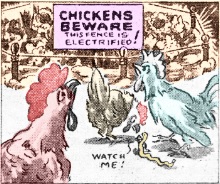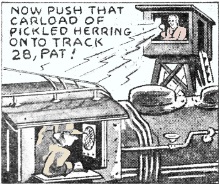|
Aug/Sep 1940 National Radio News
 [Table
of Contents] These articles are scanned and OCRed from old editions of the
National Radio News magazine. Here is a list of the
National Radio News articles I have already posted. All copyrights are hereby acknowledged. [Table
of Contents] These articles are scanned and OCRed from old editions of the
National Radio News magazine. Here is a list of the
National Radio News articles I have already posted. All copyrights are hereby acknowledged. |
My father used to refer
to the "sweet-voiced lady predicting the weather over and over again" as my girlfriend
because I would call the "WEather 6-1212" phone number (936-1212) so often. It really
wasn't because I was infatuated with her voice, it's that I was obsessed with weather
forecasting. Most of my free time as a kid and teenager was spent building and flying
model airplanes and rockets,
and at eighteen years of age I began taking full-size aeroplane flying lessons,
so my world revolved around a zone extending from terra firma up to about 5,000
feet AGL. This collection of communications news items in a 1940 edition of National
Radio News includes the creation of that very recorded weather forecasting service
(we lived about 30 miles east of Washington, D.C.). Now, I admit to having a bit
more of a problem explaining my frequent calling of the local time annunciator lady
at "TIme 4-1212" (844-1212).
Novel Radio Items
By L.J. Markus
 When Washington residents dial WEather
1212, they hear a sweet-voiced lady predicting the weather over and over again.
Those who would like to enjoy the voice indefinitely are cut off automatically after
about nine reports. A $20,000 telephone company gadget provides this unique service.
The report, as read by a young lady selected for clearness of speech, is recorded
on an endless wire tape by magnetizing the molecules in the tape in proportion to
the variations in the audio signals. The message can be erased by a second magnet
in preparation for re-recording whenever the U. S. Weather Bureau decides to change
its prediction.
|
 A St. Louis resident complained to the
sheriff's office that his chickens were being shocked by an electric fence put up
by a neighbor. The deputy who investigated found that a bare wire, supported on
insulators at the level of a chicken's head, had been erected around a flower bed
to discourage destruction of young plants by the chickens. Since this fence was
on private property, the law decided the neighbor was entirely within his rights
in maintaining the fence. The officer gave orders, however, that a sign be erected
warning that the fence was charged. It is now up to the complainant's chickens to
learn how to read.
|
 Experiments in the transmission of orders
by radio from the central control tower of a railroad freight yard to switching
locomotives are being conducted by the Central Railway Signal Company of Proviso,
Illinois, after receiving authorization for this purpose from the Federal Communications
Commission. Construction permits were issued for two 15-watt stations, one operating
somewhere between 300,000 and 400,000 kc., and the other being assigned to four
different frequencies in the range from 35,000 to 40,000 kc. This newest application
of radio may mean hundreds of additional jobs for men with radio training.
|
|
Portable Radios Are Nuisance
Portable radio receiver are the newest menace facing radio engineer during broadcast
pick-ups from remote points, according to a report from station KDYL of Salt Lake
City. Members of the audience at the scene of a remote broadcast tune their portables
in on KDYL, thereby creating feed-back. Before future broadcasts, engineers plan
to seek out the portable radios and issue appropriate instructions or warnings.
----- n r i -----
Phonograph Sells Tune for Penny
An automatic phonograph which will play any one of ten different songs when a
penny is inserted, has been developed recently by Dr. Gordon K. Woodward, a Los
Angeles physician. The special record used with this phonograph is sixteen inches
in diameter, and contains ten separate songs on each side.
----- n r i -----
KDKA Changes Tubes Automatically
Broadcast interruptions due to rectifier tube failures are eliminated in the
new 50-kilowatt transmitter of KDKA at Allison Park, Pennsylvania, by tube-changing
relays. These automatically disconnect a burned-out tube from the circuit and connect
a new tube into the circuit.
|
Electrolytics Freeze at Little America
Not a single mercury vapor rectifier tube is used in the dozen of transmitters
and receivers for the Byrd Antarctic Expedition. All rectifiers are of the high-vacuum
type, for mercury is slow to vaporize at the low temperatures encountered. Likewise,
there are no electrolytic condensers in any part of equipment. Apparently the electrolyte
freezes at temperatures below zero, for chief radioman Bailey says you might just
as well use block of wood.
----- n r i -----
Electronic Speedometer for Typists
Typing speed is indicated directly in words per minute by a unique new electronic
gadget employing two radio tubes and a vacuum tube voltmeter. Hitting a typewriter
key closes a relay circuit, thus applying a charging impulse to a condenser. Between
strokes, a motor-driven cam switch discharges the condenser a certain amount through
a resistor. A vacuum tube voltmeter connected across the condenser is calibrated
to read words per minute instead of volts.
|
Posted July 8, 2022
(updated from original post on
5/1/2014)
|



